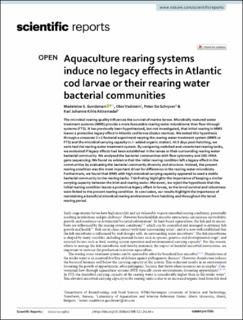| dc.contributor.author | Gundersen, Madeleine S. | |
| dc.contributor.author | Vadstein, Olav | |
| dc.contributor.author | De Schryver, Peter | |
| dc.contributor.author | Attramadal, Kari | |
| dc.date.accessioned | 2022-11-21T08:22:19Z | |
| dc.date.available | 2022-11-21T08:22:19Z | |
| dc.date.created | 2022-11-18T16:44:49Z | |
| dc.date.issued | 2022 | |
| dc.identifier.citation | Scientific Reports. 2022, 12, . | en_US |
| dc.identifier.issn | 2045-2322 | |
| dc.identifier.uri | https://hdl.handle.net/11250/3033033 | |
| dc.description.abstract | The microbial rearing quality influences the survival of marine larvae. Microbially matured water treatment systems (MMS) provide a more favourable rearing water microbiome than flow-through systems (FTS). It has previously been hypothesised, but not investigated, that initial rearing in MMS leaves a protective legacy effect in Atlantic cod larvae (Gadus morhua). We tested this hypothesis through a crossover 2 × 2 factorial experiment varying the rearing water treatment system (MMS vs FTS) and the microbial carrying capacity (+ /− added organic matter). At 9 days post-hatching, we switched the rearing water treatment system. By comparing switched and unswitched rearing tanks, we evaluated if legacy effects had been established in the larvae or their surrounding rearing water bacterial community. We analysed the bacterial communities with flow cytometry and 16S rRNA gene sequencing. We found no evidence that the initial rearing condition left a legacy effect in the communities by evaluating the bacterial community diversity and structure. Instead, the present rearing condition was the most important driver for differences in the rearing water microbiota. Furthermore, we found that MMS with high microbial carrying capacity appeared to seed a stable bacterial community to the rearing tanks. This finding highlights the importance of keeping a similar carrying capacity between the inlet and rearing water. Moreover, we reject the hypothesis that the initial rearing condition leaves a protective legacy effect in larvae, as the larval survival and robustness were linked to the present rearing condition. In conclusion, our results highlight the importance of maintaining a beneficial microbial rearing environment from hatching and throughout the larval rearing period. | en_US |
| dc.language.iso | eng | en_US |
| dc.publisher | Springer Nature | en_US |
| dc.rights | Navngivelse 4.0 Internasjonal | * |
| dc.rights.uri | http://creativecommons.org/licenses/by/4.0/deed.no | * |
| dc.title | Aquaculture rearing systems induce no legacy effects in Atlantic cod larvae or their rearing water bacterial communities | en_US |
| dc.title.alternative | Aquaculture rearing systems induce no legacy effects in Atlantic cod larvae or their rearing water bacterial communities | en_US |
| dc.type | Peer reviewed | en_US |
| dc.type | Journal article | en_US |
| dc.description.version | publishedVersion | en_US |
| dc.source.volume | 12 | en_US |
| dc.source.journal | Scientific Reports | en_US |
| dc.identifier.doi | 10.1038/s41598-022-24149-x | |
| dc.identifier.cristin | 2076605 | |
| dc.source.articlenumber | 19812 | en_US |
| cristin.ispublished | true | |
| cristin.fulltext | original | |
| cristin.qualitycode | 1 | |

